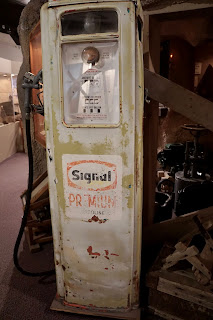The Clark County has a long and fascinating history. To learn about Southern Nevada's colorful past we've visited the Clark County Museum.
Most of Nevada was covered with warm, shallow, inland seas and lakes. As the years passed and the water receded, coral reefs became limestone, seafloor sediments became sandstone, plankton remains became shale.


The Dire wolf was a very successful hunter and scavenger.
To the Paiutes, the desert valleys and surrounding mountains were a treasure trove of food, clothing and shelter. The diorama depicts a small encampment. The woman is wearing a rabbit fur robe and a basketry hat. The baby is wrapped on a basketry cradle.
 Among the early explorers in Southern Nevada were Francisco Garces, a Franciscan monk (1770s - 1840s)
Among the early explorers in Southern Nevada were Francisco Garces, a Franciscan monk (1770s - 1840s)
Las Vegas Ranch Bell. O.D. Gass had this bell cast in Pioche and installed it on the ranch house in the 1870s.
Most pioneers had very little with which to set up a household. Settlers were sometimes isolated and unable to buy or trade for goods they needed. They were further hampered in their efforts to begin farming by the harsh desert environment which required irrigation for crops to grow. Despite these difficult conditions, many people persevered and eventually prospered in their new home.
Temporary camp on Las Vegas Creek. Shortly after the turn of the 20th century, J. T. Mcwilliams created the "Original Las Vegas Town," as he called it. However, it was the auction of William A. Clark's Las Vegas Townsite in early May of 1905 that brought in hundreds of speculators from many areas, particularly southern California. They set up haphazard, temporary camps along the creek and waited for the auction.
We hope you enjoyed few photos and learned little about Southern Nevada's pass. Thank you for reading.









